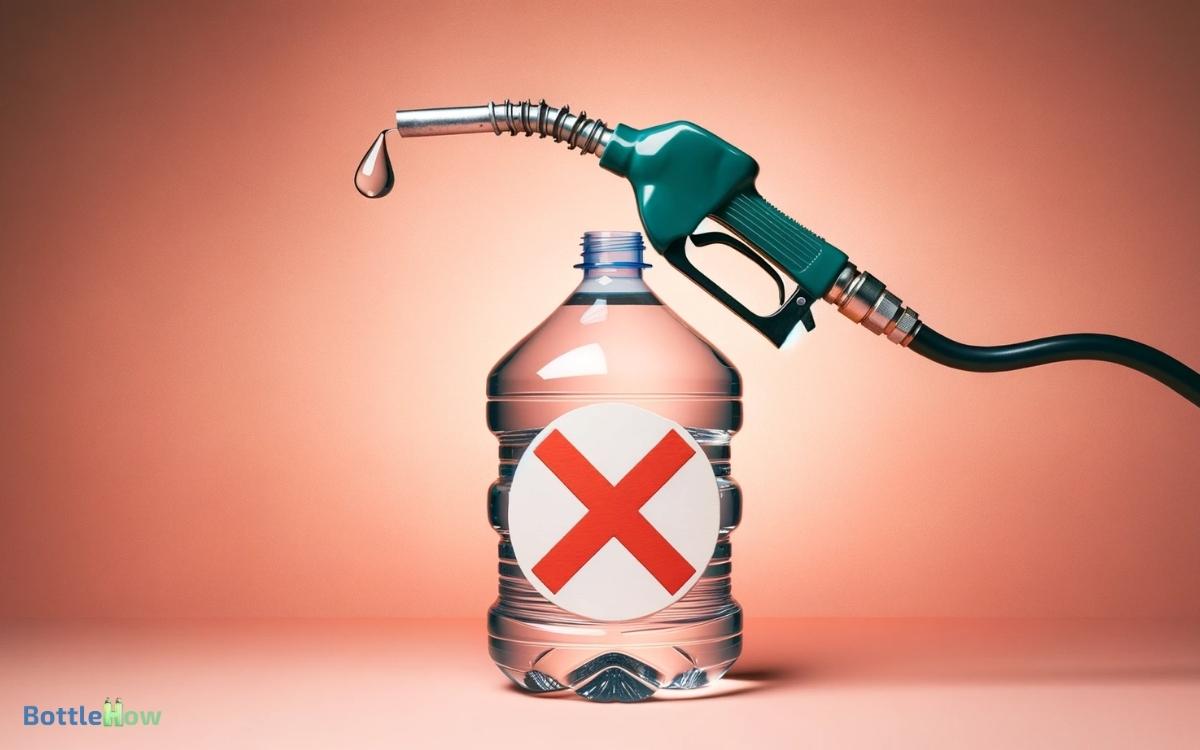Can You Put Gas in a Water Bottle? No!
You shouldn’t put gas in a water bottle. Water bottles aren’t chemically resistant to gasoline, leading to leaks and potential ruptures.
Gasoline’s flammable vapors can easily escape, creating fire hazards and toxic fume risks. The plastic in water bottles degrades quickly when in contact with gasoline, compounding contamination and storage issues.
Always use approved fuel containers made from high-density polyethylene (HDPE) or metal, designed to handle gasoline safely.
They provide the necessary sealing mechanisms and resistance, ensuring safer storage and transportation.
Following these guidelines will greatly reduce the risks associated with gasoline storage. Learn about safer alternatives and best practices.

Key Takeaways
Risks of Using Water Bottles
Using water bottles to store gasoline poses significant safety risks due to their materials not being designed to handle fuel.
You should know that most water bottles are made from polyethylene terephthalate (PET), a plastic that lacks the necessary chemical resistance to gasoline.
This can lead to degradation, causing leaks or even ruptures. When gasoline leaks, it creates fire hazards and exposes you to harmful fumes.
Additionally, water bottles lack the proper sealing mechanisms to prevent vapors from escaping, further increasing the risk of ignition.
Handling gasoline requires containers specifically designed for fuel, often made from high-density polyethylene (HDPE) with secure, vapor-tight lids.
Always opt for approved fuel containers to safeguard your safety and the safety of those around you.
Chemical Properties of Gasoline
Gasoline, a complex mixture of hydrocarbons, exhibits highly volatile and flammable properties that necessitate careful handling and storage.
You’ll find that gasoline’s volatility means it evaporates quickly, releasing flammable vapors into the air. These vapors can ignite with a mere spark, posing significant fire hazards.
Additionally, gasoline contains various additives to enhance engine performance, but these chemicals can be toxic if inhaled or ingested.
Handling gasoline requires stringent safety measures. You should always store it in containers specifically designed for flammable liquids. Any deviation from proper storage can result in dangerous leaks or spills.
Remember, gasoline is also highly reactive, meaning it can interact with other substances, potentially leading to hazardous chemical reactions.
Always prioritize safety when dealing with gasoline.
Plastic Container Reactions
Have you ever considered why gasoline should never be stored in a regular plastic container? Gasoline is a potent solvent that can degrade most plastics.
When gasoline interacts with plastics, it can cause chemical reactions that weaken the material, leading to leaks or container failure.
This is especially true for water bottles, which are typically made from polyethylene terephthalate (PET).
| Reaction Component | Effect on Plastic Container |
|---|---|
| Gasoline’s Solvent Properties | Breaks down plastic polymers |
| Plastic Additives | Can leach into gasoline |
| Container Integrity | Reduced, causing leaks |
| Environmental Factors | Accelerate degradation |
| Safety Risks | Increased due to leaks |
Understanding these reactions emphasizes the importance of using only approved containers designed to withstand gasoline’s chemical properties, ensuring safety and integrity.
Flammability Concerns
When you put gas in a water bottle, you greatly increase fire hazard risks due to the flammability of gasoline.
The vapor explosion danger is also heightened as gas vapors can easily ignite under certain conditions.
Unsafe storage practices, like using non-approved containers, can lead to catastrophic accidents.
Fire Hazard Risks
The volatile nature of gasoline makes storing it in a water bottle an extreme fire hazard. Gasoline’s high flammability means it can ignite easily, even from a small spark or static electricity.
Water bottles, typically made of thin plastic, don’t provide any fire resistance. They can easily melt, crack, or rupture, leading to dangerous spills.
This can expose you to immediate fire risks, especially in environments with potential ignition sources.
Additionally, gasoline vapors can permeate through the plastic, creating a flammable atmosphere around the bottle. Always use proper, approved containers specifically designed for gasoline storage.
Following these guidelines can greatly reduce the risk of fire and ensure a safer environment for everyone.
Vapor Explosion Danger
Gasoline vapors can create an explosive environment, posing significant flammability concerns when stored improperly.
When you use a water bottle for gasoline, you risk a vapor build-up due to the bottle’s inadequate sealing and material properties. These vapors are highly flammable and can ignite with a small spark or static discharge.
It’s essential to understand that gasoline vapor is heavier than air, causing it to settle in low areas, increasing the risk of explosion.
Always use containers specifically designed for gasoline storage, as they’re built to handle pressure and prevent vapor leakage.
Your safety depends on recognizing these dangers and taking appropriate measures to store gasoline in approved, safe containers to mitigate explosion risks effectively.
Unsafe Storage Practices
Improperly storing gasoline in containers like water bottles not only increases the risk of vapor build-up but also poses severe flammability hazards. Gasoline vapors are highly volatile and can ignite with minimal exposure to heat or sparks.
Water bottles aren’t designed to contain such volatile substances; they lack the necessary structural integrity and safety features.
When gasoline is stored inappropriately, the risk of accidental ignition greatly increases, endangering both you and your surroundings.
Always use approved gas cans, which are engineered to handle the chemical properties of gasoline, including its high flammability.
These containers minimize vapor release and are built to withstand temperature changes, reducing the risk of accidental fires or explosions.
Prioritize safety—never store gas in water bottles.
Health Hazards
You expose yourself to significant health risks by putting gas in a water bottle. Chemical contamination from gasoline can lead to severe poisoning if ingested.
Even small amounts can result in fatal outcomes, highlighting the critical need for proper storage.
Chemical Contamination Risks
Handling gasoline inappropriately can lead to severe chemical contamination, posing significant health hazards.
Gasoline contains volatile organic compounds (VOCs) like benzene, toluene, and xylene, which can leach into plastic water bottles, compromising their integrity.
When gasoline interacts with these plastics, it can cause degradation, leading to leaks and spills. Inhalation of VOCs can result in respiratory distress, dizziness, and long-term neurological damage.
Skin contact with contaminated surfaces can cause dermatitis or more severe chemical burns.
Additionally, improper storage increases the risk of accidental ingestion or environmental contamination.
You must always use containers specifically designed for gasoline storage to mitigate these risks and promote both personal and environmental safety. Prioritize proper handling and storage to avoid hazardous exposure.
Ingestion Fatalities Potential
Accidental ingestion of gasoline from non-approved containers like water bottles can lead to severe, potentially fatal health complications.
When you accidentally consume gasoline, it can cause immediate damage to your mouth, throat, and stomach lining.
Gasoline’s toxic components are rapidly absorbed into your bloodstream, affecting your central nervous system and potentially leading to respiratory failure.
Symptoms include dizziness, headache, vomiting, and convulsions. Even a small amount can cause chemical pneumonia if aspirated into the lungs.
Swift medical intervention is critical to mitigate these life-threatening risks. Always store gasoline in approved, clearly labeled containers and keep them out of reach of children to prevent accidental ingestion. Your safety should never be compromised by improper storage practices.
Environmental Impact
Storing gasoline in a water bottle greatly increases the risk of environmental contamination due to potential leaks and improper disposal.
When gasoline leaks, it can seep into soil and groundwater, posing significant risks to ecosystems and human health.
A water bottle isn’t designed to contain volatile substances; its materials can degrade, leading to spills.
If you discard a gasoline-filled water bottle improperly, you risk contaminating landfills and waterways.
Additionally, gasoline vapors contribute to air pollution and can exacerbate respiratory issues. Even small amounts can have large-scale environmental impacts.
You must recognize these dangers and avoid using inadequate containers for gasoline. Proper containment is essential to minimizing environmental harm and ensuring safety.
Proper Fuel Storage
You must use approved fuel containers to guarantee safety and compliance with regulations. These containers are specifically designed to handle the volatile nature of gasoline and prevent leaks and spills.
Always store fuel in a well-ventilated area away from ignition sources to minimize the risk of fire or explosion.
Approved Fuel Containers
Using approved fuel containers is crucial for guaranteeing both safety and fuel quality during storage. You need to understand that only specific containers are designed to handle gasoline.
These containers are generally made from materials like high-density polyethylene (HDPE) or metal and include features to prevent spills and leaks.
| Feature | Importance |
|---|---|
| Material | HDPE or metal for durability |
| Spill-Proof Cap | Prevents leaks and evaporation |
| Flame Arrestor | Reduces risk of ignition |
| Certification | Compliance with safety standards |
Using improper containers, like water bottles, can lead to hazardous situations and fuel degradation.
Always use containers that meet regulatory standards, such as those certified by Underwriters Laboratories (UL) or the Department of Transportation (DOT). Following these guidelines guarantees both your safety and the integrity of the fuel.
Safety Storage Practices
Proper fuel storage demands meticulous attention to safety guidelines to minimize risks of fire, contamination, and environmental harm.
You should always use containers specifically designed for fuel, which are generally made from materials resistant to gasoline’s corrosive properties.
Store fuel in well-ventilated areas away from any ignition sources, such as stoves or heaters. Make sure the storage area is cool and dry, as heat and moisture can degrade fuel quality and increase hazards.
Label containers clearly to avoid any confusion. Regularly check for leaks and ensure caps are tightly sealed.
Never fill containers beyond their capacity; leave some space for fuel expansion. Following these practices guarantees safety and prolongs the usability of the stored fuel.
Legal Implications
Transporting gasoline in a water bottle not only poses significant safety hazards but also violates numerous local, state, and federal regulations.
You must understand the legal implications of this action to avoid severe penalties. Authorities have strict rules to guarantee public safety and environmental protection.
- Federal regulations: The U.S. Department of Transportation requires proper containers for fuel transport.
- State laws: Individual states may impose additional restrictions and penalties.
- Environmental laws: Improper fuel storage can lead to hazardous spills, violating environmental protection laws.
- Fire codes: Local fire departments enforce regulations to prevent fire hazards.
Safer Alternatives
When considering safer alternatives for transporting gasoline, always choose containers that are specifically designed and approved for fuel storage.
These containers are made from materials that resist corrosion and prevent leaks, reducing the risk of fire and environmental contamination.
You should never use makeshift containers, like water bottles, as they can dissolve or rupture, posing significant dangers.
Here’s a comparison table to guide you:
| Container Type | Safety Level | Durability |
|---|---|---|
| Approved Gas Can | High | High |
| Plastic Water Bottle | Very Low | Very Low |
| Metal Jerry Can | High | High |
Emergency Fuel Solutions
In the event of an unexpected fuel shortage, knowing the right emergency fuel solutions can mean the difference between safety and disaster. You should always prioritize safety and legal considerations.
Here are four emergency fuel solutions:
- Fuel Transfer Pump: Utilize a portable fuel transfer pump to safely move fuel from one vehicle to another.
- Approved Gas Containers: Always carry an approved gas container; it’s designed to handle gasoline safely.
- Siphoning Kit: Use a siphoning kit as a last resort. Make sure you follow all safety guidelines to avoid ingestion or spills.
- Fuel Additives: Keep fuel stabilizers or additives to extend your current fuel’s life in an emergency.
Conclusion
You absolutely shouldn’t put gas in a water bottle. The chemical reactions between gasoline and plastic can turn your bottle into a ticking time bomb. Over time, the gasoline can weaken the plastic, causing it to degrade and potentially leak dangerous fumes. The pressure buildup inside the bottle can make it behave unpredictably—almost like shaking up champagne in a water bottle, but with far more hazardous consequences. A small spark or static discharge could turn the entire situation into a serious fire risk.
The flammability of gas, combined with improper storage, poses severe health hazards and legal risks. For your safety and those around you, always use approved containers for fuel storage.
When it comes to emergencies, explore safer alternatives to avoid catastrophic outcomes. Your life’s worth more than a cheap plastic bottle.





